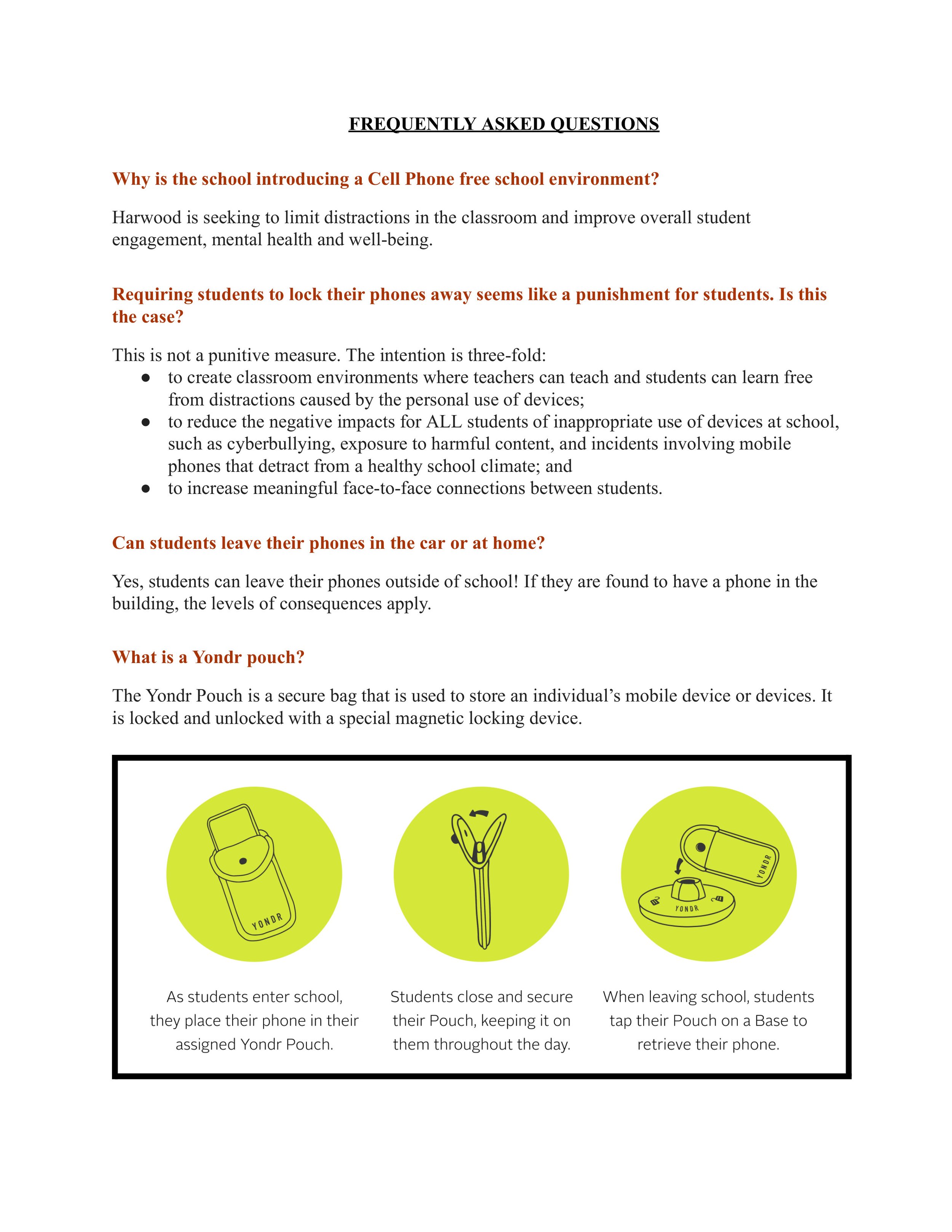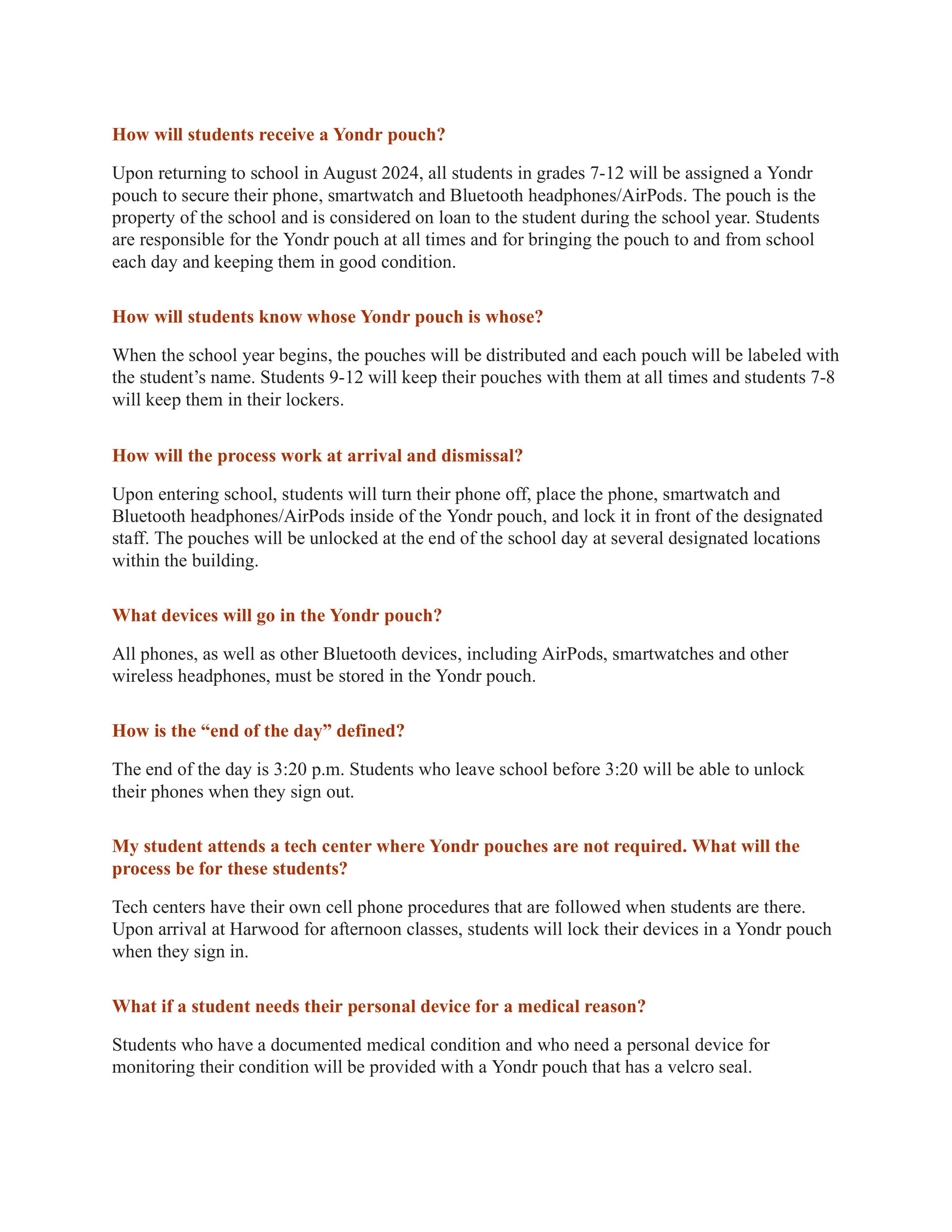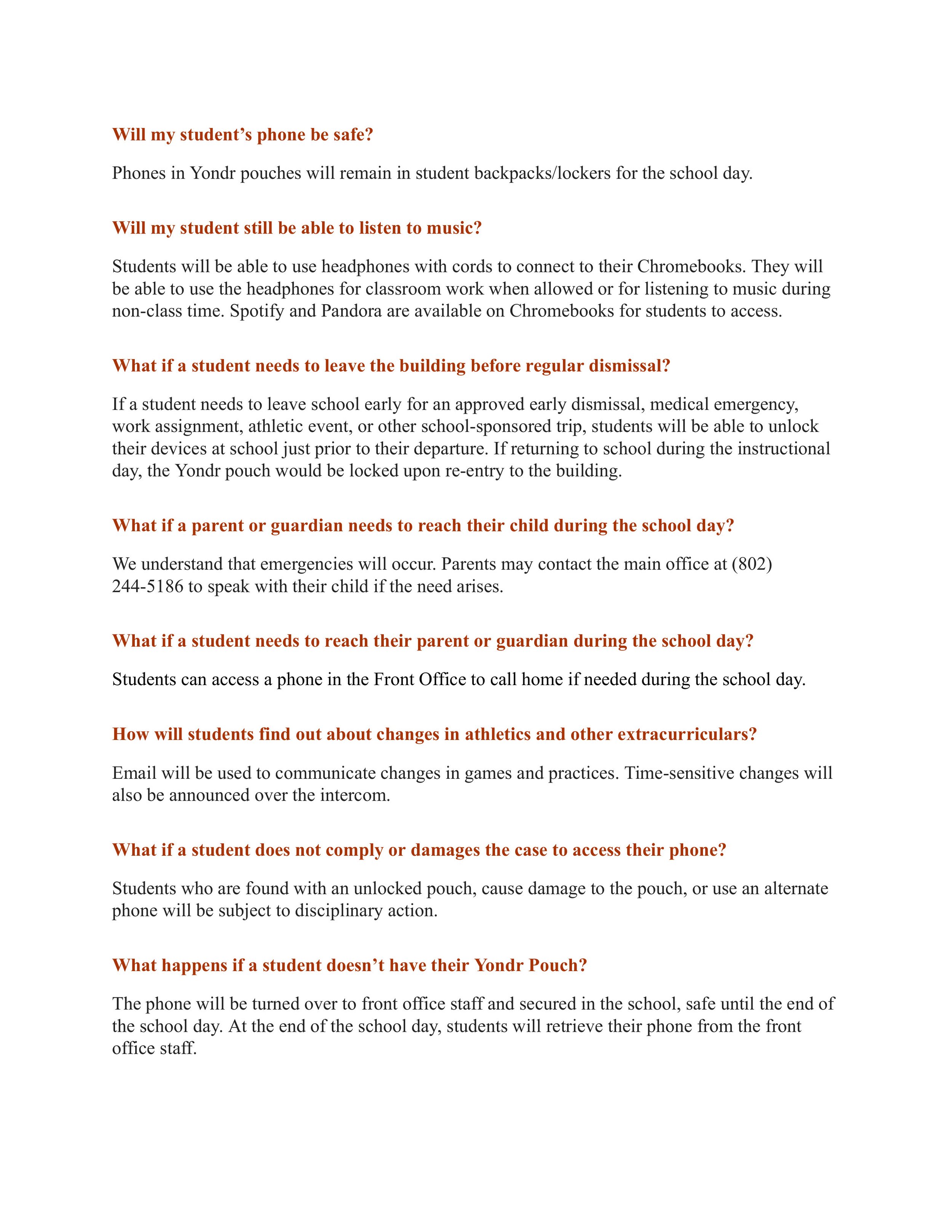Lock it up: Harwood memo outlines new phone-free school rules
July 31, 2024 | By Lisa ScagliottiWith the first day of school less than a month away, principals at Harwood Union Middle/High School have announced details for the new school policy to keep students’ cell phones locked away during the school day in an effort to reduce distractions and improve learning and socializing.
On Aug. 27 and 28, Harwood students in grades 7 through 12 will be issued a special locking pouch to store their phones and other personal bluetooth-technology devices such as earphones and smartwatches.
At Harwood, 7th and 9th graders start school Aug. 27; 7-12 grade classes will be in session on Aug. 28. File photo
The move is meant to make the school a “phone-free space in order to continue strengthening engagement across our community and improve overall student mental health and well-being,” explains a July 25 memo from high school Co-Principals Laurie Greenberg and Megan McDonough and middle school Assistant Principal Bethany Turnbaugh.
School leaders this spring announced plans to address cell phone use among students for the upcoming 2024-25 school year. Until now, students in grades 7-8 have been required to store phones in their lockers during the school day. High school students have not had formal restrictions beyond what teachers have required in individual classes.
School staff and administrators said they decided to take on the issue because the presence of student phones in school is distracting, disruptive and detrimental to learning. A community meeting in late May to discuss the shift for the coming year attracted a couple dozen parents and twice as many staff. Student participants led small-group discussions posing the question: “How will a break from cell phones affect connection, engagement and learning at Harwood?”
Administrators shared with participants excerpts from research on the subject that backed up their rationale to prevent student access to phones during the school day. The research delves into the frequency adolescents and teens spend on phones, the level of distraction that phones present, and the resulting impacts on learning, socialization, behavior and mental health.
The idea to use pouches that students keep with them during the day came from an all-school assembly at the end of last school year, Greenberg said in an interview this week. Students said they would be more comfortable not having to turn phones in and retrieve them, she recalled. “This seemed like the easiest approach,” she said.
There weren’t many suppliers to choose from or other schools in Vermont to look to for examples. “We really are leading the state in this initiative,” Greenberg said.
The memo emailed to students and parents last week explains that the district has purchased special pouches from a California company called Yondr to store electronic devices during the school day. “Yondr has been implemented in over 2,000 schools across 16 countries and they have consistently found that learning and social behavior improve drastically when students are fully engaged with their teachers and classmates,” the memo says.
Yondr says its surveys of school customers have found marked improvements in student engagement, behavior and academic performance when the storage pouches are implemented.
The pouches can fit a phone, earbuds and a smartwatch. They have a special magnetic closure that is activated on and off by tapping it on a base device.
Locking and unlocking
The school memo explains how the process will work during arrival and dismissal: “Upon entering school, students will turn their phone off, place the phone, smartwatch and Bluetooth headphones/AirPods inside of the Yondr pouch, and lock it in front of the designated staff. The pouches will be unlocked at the end of the school day at several designated locations within the building.”
A school graphic made in the spring announces the shift in school policy.
Greenberg said school leaders are figuring out the details for how arrival and dismissal will work with the locking/unlocking stations near building entrances. Staff will oversee the process, the memo says, “but it is the responsibility of students to follow this expectation.”
Students in middle school grades will be expected to leave their locked pouches in their lockers; students in high school can have their pouches in their backpacks during the school day. Students have the option to leave phones at home or for those who drive to school, they can leave phones in their vehicles, the memo notes.
Students with a medical condition who need an electronic device for monitoring their condition during the school day will be issued a special pouch with a velcro seal that they can open, the memo also explains.
The recent email contains more than five pages of details regarding the new expectations. Greenberg said the information will be posted on the school website soon along with additional details that will be sent out in upcoming communications.
In the memo section with questions/answers related to the new policy, the question of compliance is raised. “Students who are found with an unlocked pouch, cause damage to the pouch, or use an alternate phone will be subject to disciplinary action,” the memo states. It does not specify what the disciplinary steps would be.
Greenberg said those details will be included in additional information ent out before school starts. It will have specifics on the step-by-step process to be used with the pouches and it will convey consequences regarding infractions of the new policy, she said.
Once school starts, administrators will make time for regular staff meetings to keep track of how the new routine is working out. “We are setting up different systems to allow for that feedback,” Greenberg said. “We expect the first few months are going to be very, very busy.”
School leaders emphasize that the goal of this effort is “deeper engagement for our students.” Their message is that the new rules are not meant as a punishment. “The point is not to take something away,” Greenberg said. “We want students to be engaged in the classroom. We want them to be engaged with their peers and in person, not through a device.”
Federal funds cover the cost
According to the Yondr website, the pouches are priced between $25 and $30 each. Greenberg said Harwood has purchased 667 pouches – one for every 7th-through-12-grader with additional spares to have on hand as needed. The school should have 580 students this fall, she said.
The purchase is to be covered with $21,000 from the final round of federal COVID fund through the Elementary & Secondary School Emergency Relief (ESSER) program. The Harwood district received just over $4.8 million in ESSER funding over three phases since 2020. Its allocation was documented using a process outlined by the federal government that calls for a spending plan with public input and school board oversight.
The Harwood school board has reviewed and approved the ESSER grant spending over the past several years. The last such request was in early May when Director of Curriculum & Technology Shannon Lessley told the board that the 2024-25 budget did not have enough funding to pay for summer school programs this year. Lessley and Finance Manager Lisa Estler outlined how the remaining unspent ESSER funds could cover most of the summer school budget. Estler said summer school was expected to cost just under $302,000 and remaining ESSER funds would leave about $250,000 to help cover that expense. The board unanimously approved that request.
Since then, Greenberg said, the ESSER account still had unused funds that could be used for the phone pouches and equipment. That decision was made after the Harwood school board took its summer break, however, so the board has not yet approved the allocation, Greenberg said. In order to meet a July 31 deadline, the district requested permission from the state Agency of Education to use ESSER funds for the pouches. The funds must be spent by Sept. 30. If the request is denied, the district would pay for the phone pouches from its regular supply budget, Greenberg explained.
The school board resumes its regular meeting schedule on Aug. 28. The first day of the 2024-25 school year across the Harwood district is Tuesday, Aug. 27. At Harwood Union Middle/High School, only seventh and ninth graders attend on the first day to ease their transition to their new routines. All students in grades 7-12 will attend on Aug. 28.
Below is the memo sent to Harwood families on July 25. This and more information will be posted on the Harwood website soon.









